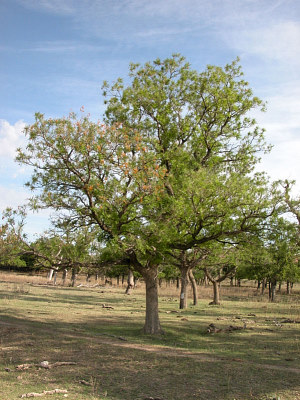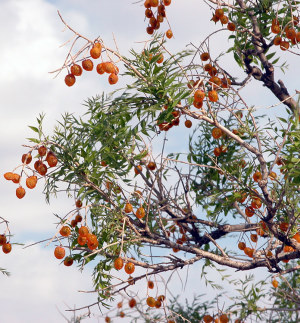Western Soapberry, Jaboncillo
Sapindus saponaria L. (Hook. & Arn.) L. Benson
Sapindaceae Family
Western soapberry is a small tree that grows to 35 feet. The mature tree has a rounded crown and a trunk that measures up to two feet in diameter. Its flexible yet strong young branches (shoots) were used to make arrow foreshafts. Its seeds and sap were sometimes used for medicinal purposes.
Western soapberry has attractive, pinnately compound leaves and beautiful, but poisonous, golden fruits. The tree grows along fence rows and river valleys from Louisiana west across the southern Plains and into the Chihuahuan and Sonoran Deserts, but it is confined to canyons and arroyos in the western margins of its territory (Cox and Leslie 1988; Young and Young 1992).
Western soapberry gets its name from the fruit, which contains over 30% saponins. Saponins are chemicals that are a combination of steroids and sugars that foam when water is added and the mixture is agitated (Nobel 1988). The foaming property of the saponins makes the berries a useful detergent, but when taken internally the chemicals disrupt animal cells; hence soapberry fruit is considered toxic.
Archeological occurrence. Charred fragments of western soapberry wood were identified in Hinds Cave (Dering 1979). The archeological occurrence of this plant is probably much more widespread in rockshelter deposits of the Lower Pecos region, but Hinds Cave is the only site from which unscreened deposits have been recovered and investigated.
Medicine. Although the high saponins content renders western soapberry somewhat toxic, the seed was used for some medicinal applications. The Kiowa utilized the sap in a poultice used for soothing wounds (Vestal and Schultes 1939).
Implements/weapons. More than one group found the wood to be useful for making arrows. The Comanches fashioned arrows from the stems of western soapberry (Carlson and Jones 1940). The Papago used the wood of soapberry to make the foreshaft of their arrows. Ruth Underhill has provided a fairly detailed account of this process.
The bark was peeled off of slender green soapberry stems, which then were straightened and dried. They arrow maker then split the tip of the dried shaft, inserted the small stone arrow point, and tied it with wet sinew. The account notes that a gum from brittlebush (Encelia farinosa) was utilized to cement the tip to the shaft; however, brittlebush does not grow on the Edwards Plateau or eastern Chihuahuan Desert (Castetter and Underhill 1935). We do not know what type of gum may have been used in our region. The arrow artisan would make the main arrow shaft from soaptree yucca (Yucca elata) or from common reed (Phragmites communis). Common reed grows throughout the area, but on the Edwards Plateau, Thompson yucca flower stalks would have been used instead of the soaptree, which grows further west in the Trans-Pecos region. A hole two-inches deep was hollowed into the end of the arrow shaft so that the foreshaft (fashioned of soapberry) could be inserted. Once inserted, sinew was wound tightly around the entire length of the hollowed out area (Castetter and Underhill 1935).
References:
Carlson, Gustav G. and Volney H. Jones
1940 Some Notes on Uses of Plants by the Comanche Indians. Papers of the Michigan Academy of Science, Arts, and Letters 25:517-542.
Castetter Edward F. and Ruth Underhill
1935 The Ethnobiology of the Papago Indians. Ethnobiological Studies in the American Southwest. Vol. II. The University of New Mexico Bulletin, Biological Series 4(3). Albuquerque, New Mexico.
Cox, Paul and Patty Leslie
1988 Texas Trees: A Friendly Guide. Corona Publishing Co. San Antonio, Texas.
Dering, J. Philip
1979 Pollen and Plant Macrofossil Vegetation Record Recovered from Hinds Cave, Val Verde County, Texas. Unpublished Masters Thesis. Texas A&M University. College Station, Texas.
Vestal, Paul A. and Richard E. Schultes
1939 The Economic Botany of the Kiowa Indians. Botanical Museum of Harvard University. Cambridge, Massachusetts.
Young, James A. and Cheryl G. Young
1992 Seeds of Woody Plants in North America. Disocorides Press. Portland, Oregon.
![]()

